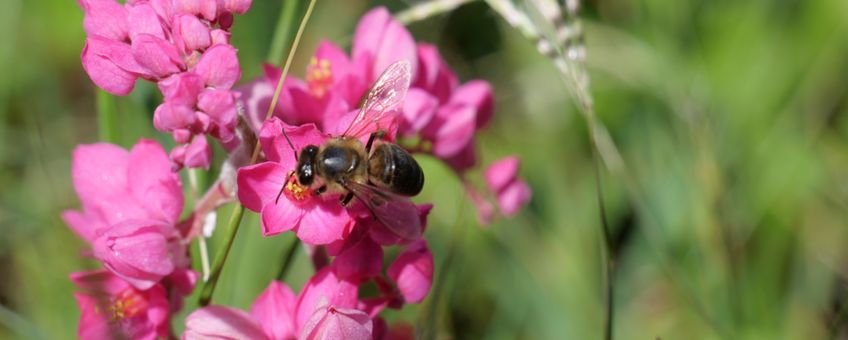
Drastic effects of coralita on the biodiversity of insects and spiders
Dutch Caribbean Nature Alliance (DCNA), Vrije Universiteit AmsterdamCoralita invasion
It is a beautiful and colorful plant, but so dominant! The colorful plant coralita, also known as Mexican creeper plant or coral vine (Antigonon leptopus), was introduced as an ornamental plant on Saba, Sint Eustatius and many other Caribbean islands. Alarmingly, the invasion of coralita has led to a total change in animal communities on Sint Eustatius. This plant originates in Mexico, where it poses no threat since its numbers are regulated by droughts. However, on humid islands like St. Eustatius, it can grow unchecked. It spreads both horizontally on fields and vertically against all kinds of objects. In addition, goats prefer to eat native grasses and do not eat coralita unless they are forced to from an early age.
Studying the impact of urban development and coralita invasion

"There are only a few studies that manage to assess both factors separately", claims Wendy Jesse. "That was possible in this case because this invasive plant is very abundant and occurs everywhere, both in urban areas of Oranjestad and in and around the long abandoned agricultural plots around the dormant Quill-volcano. As much as 33 percent of the island is entirely or partially overgrown with coralita." explained Wendy Jesse.
The PhD research of Wendy Jesse on Sint Eustatius is part of a Netherlands Organization for Scientific Research (NWO) project about bioinvasions on the Dutch Caribbean Islands and is coordinated by the Vrije Universiteit Amsterdam.
Results
A total of 4,690 spiders and insects were captured. Within two months, the team completed the enormous task of identifying and assigning each specimen to one of six feeding guilds based on their dietary habits: herbivores, nectarivores, predators, parasitoids, detrivores or omnivores. In total 185 species were identified and classified.
"Our results show that urban development increases species richness as well as the diversity of individuals divided over species, the so-called abundance-weighted or Shannon diversity. Invasion by coralita mostly caused increased occurrence of certain feeding guilds, with extraordinary quantities of nectarivores, herbivores and detrivores. This causes biotic homogenization of insect and spider communities which simply means that you get more of the same", explained Wendy Jesse. Invasive species, like coralita, are thus not just a result of urban development but are also a driver of change themselves.
Safeguarding biodiversity
Such an invasion has big consequences for the environment on St. Eustatius, because insects and spiders provide important ecosystem services like pollination, decomposition and nutrient cycling, and serve as a food source for native reptiles and birds. In earlier research the same group of scientists have shown that when coralita appears, reptiles such as anolis lizards disappear. Without the recovery of native vegetation, the loss of biodiversity on the Dutch Caribbean Islands is likely.
Receive nature-news
Stay updated about nature research and monitoring projects in the Dutch Caribbean through the Dutch Caribbean Nature Alliance’s (DCNA) free digital newsletter BioNews.
More information
The complete article (Disentangling the effects of plant species invasion and urban development on arthropod community composition) can be found here.
Text: Gert van Maanen, Bionieuws, Jasper Molleman and Wendy Jesse, Vrije Universiteit Amsterdam
Pictures: Jasper Molleman; Wendy Jesse


